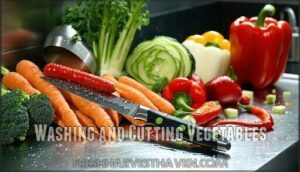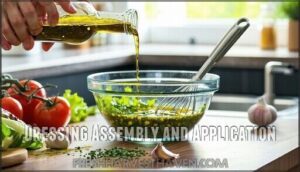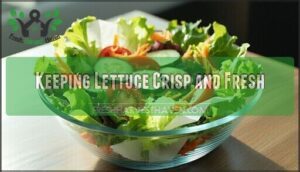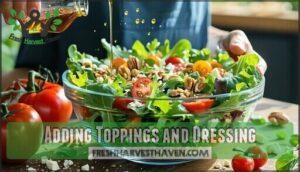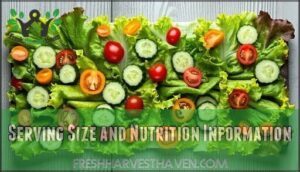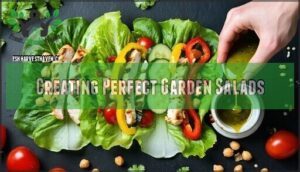This site is supported by our readers. We may earn a commission, at no cost to you, if you purchase through links.
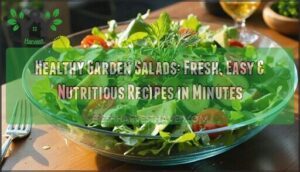 You’ll love how healthy garden salads pack serious nutrition into every colorful bite.
You’ll love how healthy garden salads pack serious nutrition into every colorful bite.
Start with mixed greens as your base, then pile on fresh cucumbers, juicy tomatoes, creamy avocado, and herbs like dill or basil.
These salads aren’t just rabbit food – they’re powerhouses loaded with vitamins, fiber, and healthy fats that keep you satisfied.
The best part? You can whip one up in under five minutes with whatever’s in your fridge.
Think of your salad bowl as a blank canvas where you can paint with nature’s rainbow.
There’s actually a secret to making every single bite taste restaurant-quality amazing.
Table Of Contents
Key Takeaways
- Start with mixed greens and add seasonal vegetables like cucumbers, tomatoes, and colorful peppers – you’ll maximize nutrition and flavor while keeping prep time under five minutes
- Choose organic produce when possible and shop at farmers markets for peak freshness – seasonal ingredients pack more vitamins and antioxidants than out-of-season options
- Add protein like grilled chicken, chickpeas, or hard-boiled eggs to transform your salad into a complete meal that’ll keep you satisfied longer
- Wait until serving time to add dressing and toppings – this prevents soggy lettuce and maintains that satisfying crunch you’re craving
Healthy Garden Salad Basics
You’ll find that making a healthy garden salad is simple, and you can use whatever fresh vegetables you like.
With each bite, you get a mix of vitamins, fiber, and crunch—plus, it’s easy to swap ingredients if you’re feeling adventurous or just want to clean out the fridge, which can also provide a good amount of fiber.
Fresh Vegetable Selection
Your fresh vegetable selection sets the foundation for nutrient-packed garden salads that’ll make your taste buds dance.
Choose seasonal vegetables like crisp romaine, juicy tomatoes, and crunchy cucumbers for peak flavor and nutrient density. Garden salads are a global staple, reflecting diverse local ingredients.
- Organic produce: Prioritize organic options for leafy greens and vegetables eaten with skin
- Local sourcing: Visit farmers markets for freshest seasonal vegetables and peak nutrition
- Vegetable prep: Select firm, vibrant produce and wash thoroughly before cutting
Smart salad ingredients mean better recipes every time.
Choose fresh, seasonal vegetables—your taste buds and body will thank you for the vibrant flavors and peak nutrition.
Nutritional Benefits Overview
Garden salads pack serious nutritional benefits that’ll make your body thank you.
You’ll get vitamin A for healthy vision, vitamin C for immune support, and vitamin K for strong bones.
The fiber benefits include better digestion and heart health, while the low calorie count helps with weight management.
These mineral sources provide potassium and iron, plus antioxidant power fights inflammation naturally.
A typical serving has a low calorie count, making it a healthy choice with antioxidant power.
Customization Options
You’ll discover countless ways to make your garden salad uniquely yours through simple ingredient swaps and creative additions.
Mix and match vegetables, proteins, and dressings to create recipe variations that match your taste preferences and healthy eating habits.
- Cheese choices: Crumbled goat cheese, feta, or sharp cheddar add richness
- Protein additions: Grilled chicken, chickpeas, or hard-boiled eggs boost nutrition
- Seed selections: Sunflower seeds, pumpkin seeds, or hemp hearts provide crunch
Garden Salad Preparation Tips
Proper preparation makes the difference between a soggy disappointment and a crisp, flavorful garden salad that’ll have you coming back for seconds.
You’ll master the simple techniques for washing vegetables thoroughly, cutting them to perfect bite-sized pieces, and timing your dressing application so everything stays fresh and delicious.
Washing and Cutting Vegetables
Rinse all vegetables under cold water to remove pesticides and bacteria before cutting.
Start with uniform sizing for even cooking and better presentation. Use sharp knives for clean cuts – peel carrots into rounds, slice celery into 1/8-inch pieces, and cut cucumbers into 1/4-inch rounds.
A quality knife set improves cutting efficiency. Proper vegetable preparation and knife skills make your salad look professional with a quality knife set.
Mixing and Tossing Techniques
After cutting your vegetables, gentle tossing becomes your secret weapon for perfect ingredient distribution. You’ll want to use your hands or large salad spoons in a spacious large bowl, preventing bruising while ensuring even mixing.
Think of it like folding laundry—soft movements create better salad presentation than aggressive stirring.
- Use clean hands or wooden spoons for the gentlest mix ingredients approach
- Toss from bottom to top in slow motions to avoid crushing delicate leaves
- Work in a large bowl with plenty of room for proper ingredient distribution
- Lift and fold vegetables rather than stirring to maintain their fresh appearance
Dressing Assembly and Application
Perfect timing with your salad prep! Now you’ll transform simple ingredients into restaurant-quality vinaigrette using proven emulsion techniques.
| Dressing Type | Key Components |
|---|---|
| Vinaigrette | Olive oil, vinegar alternatives, mustard |
| Ranch Dressing | Buttermilk, herbs, garlic |
| Italian Dressing | Oil, vinegar, herb infusions |
| Honey Mustard | Mustard, honey for sweetness balancing |
Whisk oil slowly into vinegar for stable emulsion. Add herb infusions and adjust sweetness balancing with honey.
Explore different olive oil types to enhance your vinaigrette. Store homemade salad dressing separately in sealed containers for dressing storage up to one week.
Top 3 Garden Salad Essentials
You’ll need the right tools to create restaurant-quality garden salads at home that taste fresh and look professional.
These three essentials will transform your salad-making process from tedious prep work to an enjoyable cooking experience.
1. 50 ml Deep Form Mortar Pestle
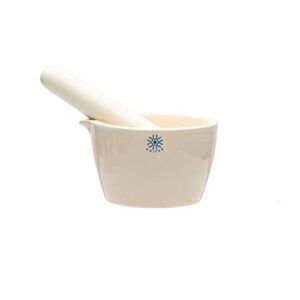
Precision becomes your secret weapon when crafting homemade dressings.
You’ll crush garlic cloves into smooth paste using this compact 50ml mortar and pestle, creating restaurant-quality vinaigrettes in minutes.
The deep porcelain bowl keeps ingredients contained while you grind herbs and spices.
It’s dishwasher-safe and perfect for small batches—no more overpowering garlic chunks ruining your salad experience.
This little kitchen workhorse transforms tough ingredients into flavor gold, making it an essential tool with compact design.
Best For: Home cooks and pet owners who need to crush pills, grind small batches of herbs and spices, or create smooth garlic paste for dressings and marinades.
- Deep porcelain design prevents spillage while grinding and is dishwasher-safe for easy cleanup
- Compact 50ml size perfect for small batches without waste, plus it’s autoclave-tested for sterilization
- Versatile tool handles everything from crushing pet medications to making restaurant-quality vinaigrettes
- Unglazed interior can retain powder residue that requires extra cleaning effort
- Small 50ml capacity may require multiple batches for larger quantities
- Not suitable for precision laboratory work due to budget-friendly construction standards
2. BARIANI Extra Virgin Olive Oil
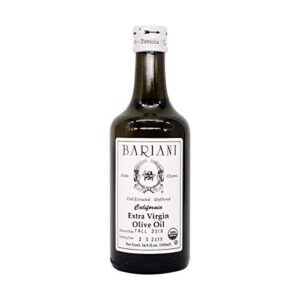
Quality matters when you’re crafting the perfect garden salad dressing.
BARIANI Extra Virgin Olive Oil delivers that authentic flavor your taste buds crave.
This California-grown oil is cold-pressed and stone-crushed, preserving natural antioxidants and polyphenols that protect your health.
With its peppery finish and grassy notes, it transforms simple vegetables into something special.
One way to enhance your salad is by considering seasonal ingredient options for variety.
The unfiltered oil provides 126 calories per tablespoon and supports heart health through beneficial monounsaturated fats.
Store it in a cool, dark place to maintain prime flavor for your homemade vinaigrettes.
Best For: Home cooks and salad enthusiasts who want authentic, high-quality olive oil with robust flavor for dressings and finishing dishes.
- Robust, bitter flavor may be too intense for those accustomed to milder supermarket olive oils
- Reports of bottle cap issues during shipping leading to oil leakage and potential waste
- Higher price point compared to conventional olive oils, though competitive within the premium category
- Stone-crushed, cold-pressed processing preserves natural antioxidants and delivers authentic peppery, grassy flavor
- California-grown and organic with traditional extraction methods ensuring freshness and quality control
- Heart-healthy monounsaturated fats and polyphenols support cardiovascular health when used regularly
3. Utopia Kitchen 5 Piece Knife Set
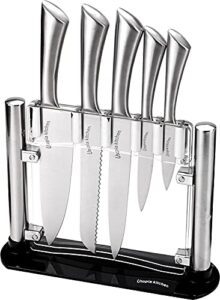
Sharp knives make all the difference when you’re prepping fresh vegetables for your garden salad.
This five-piece stainless steel set gives you everything needed – an 8-inch chef’s knife for chopping lettuce and tomatoes, plus utility and paring knives for detailed work like mincing herbs or peeling cucumbers.
The one-piece construction means handles won’t wobble during use, and to keep them sharp and rust-free, hand wash and dry immediately for years of reliable salad-making.
Best For: Home cooks, students, and budget-conscious individuals seeking a complete, versatile knife set for everyday meal preparation including fresh salad making.
- Requires hand washing only – not dishwasher safe, adding to maintenance time
- Handle-heavy weight distribution may affect cutting efficiency for some users
- Acrylic stand can be top-heavy when fully loaded and may have durability concerns
- Complete 5-piece set with specialized knives for different tasks, plus convenient acrylic storage stand
- One-piece stainless steel construction prevents handle detachment and provides superior durability
- Sharp out-of-the-box performance with rust-resistant steel that maintains edge well with proper care
Garden Salad Storage and Serving
You’ll keep your garden salad fresh and crisp by storing it properly and adding toppings at the right time.
The key is knowing when to dress your salad and how to store leftovers without losing that satisfying crunch.
Keeping Lettuce Crisp and Fresh
After thorough washing techniques and proper drying methods, store your greens right to maintain crispness.
Place a paper towel inside storage containers to absorb excess moisture that makes lettuce soggy.
A salad spinner removes water effectively, but don’t skip the paper towel trick.
A quality spinner is useful for removing excess water.
Temperature control matters too—keep your crisp lettuce refrigerated at consistent temps to preserve that satisfying crunch.
Adding Toppings and Dressing
Timing matters when adding salad toppings and salad dressing.
Wait until serving time to prevent soggy lettuce and mushy croutons.
Drizzle your homemade dressings or vinaigrette gradually while tossing gently for proper dressing emulsification.
Layer healthy toppings like nuts, seeds, and cheese strategically – heavier items first, delicate ones last.
Consider flavor pairings and topping textures when combining Italian dressing with crunchy elements, ensuring a balance that enhances the overall salad experience with proper dressing.
Serving Size and Nutrition Information
A standard serving size runs about one cup for side dishes, while main course portions typically reach 2.5 cups.
Your basic garden salad contains just 11-20 calories per cup without dressing, but adding protein and toppings can bump that to 400 calories.
You’ll get solid fiber benefits and vitamin content while keeping carbohydrates low.
Smart portion control helps maximize nutritional information without overdoing the calorie count.
To enhance flavor, consider seasonal ingredient incorporation.
Creating Perfect Garden Salads
Creating the perfect garden salad means balancing sweet tomatoes with crisp cucumbers and adding your favorite protein like grilled chicken or chickpeas.
You’ll want to use fresh, seasonal vegetables and save the dressing for the very last minute to keep everything crisp and delicious.
Balancing Flavors and Textures
Perfect garden salads need flavor harmony. Mix sweet and sour elements like cherry tomatoes with tangy vinaigrette. Add crunchy elements through nuts, seeds, or fresh vegetables.
Balance bitter greens like arugula with creamy dressings. Layer different salad ingredients for texture contrast. Combine soft lettuce with firm cucumbers and crunchy toppings for the best eating experience.
Consider adding homegrown produce, which offers superior nutrient profiles, for added health benefits.
Adding Protein for a Complete Meal
Transform your garden salads into satisfying meals by adding protein choices that keep you full longer.
Protein timing matters—aim for at least 15 grams per serving to support healthy eating goals and meal prep success.
- Animal proteins: Grilled chicken breast (27g per 3oz), hard-boiled eggs (6g each), or canned tuna provide quick options
- Vegetarian options: Chickpeas (8g per half-cup), tofu (12g per 3oz), or hemp seeds boost plant-based protein salads
- Portion sizes: Use 3-4oz cooked meat or ½ cup legumes for ideal nutritious salads and sustained energy
Using Seasonal and Organic Ingredients
Choosing seasonal produce transforms your salads into nutritional powerhouses.
Organic ingredients pack more vitamins while dodging harmful pesticides.
Visit your local farmers market for the freshest picks that taste incredible and support your community.
| Season | Best Organic Choices | Health Benefits |
|---|---|---|
| Spring | Spinach, arugula, peas | 58% more vitamin C, reduced pesticide exposure |
| Summer | Tomatoes, cucumbers, peppers | Peak antioxidants, maximum flavor |
| Fall | Kale, carrots, beets | Higher mineral content, natural sweetness |
| Winter | Brussels sprouts, cabbage | Enhanced nutrient density, crisp textures |
Frequently Asked Questions (FAQs)
What should you put in a garden salad?
A garden salad is like nature’s rainbow on your plate.
Start with crisp lettuce as your foundation, then add colorful vegetables like tomatoes, cucumbers, carrots, and onions for crunch and flavor.
What are the healthiest veggies to put in a salad?
Dark leafy greens like spinach and kale pack the most nutrients.
While colorful bell peppers, carrots, and tomatoes add vitamins A and C.
You’ll also get fiber from cucumbers and antioxidants from red onions.
Can garden salads help with weight loss goals?
Yes, you can absolutely use garden salads to support your weight loss goals.
They’re low in calories but high in fiber, which helps you feel full longer.
The key is choosing nutrient-dense vegetables and controlling your dressing portions.
Which vegetables should diabetics avoid in salads?
Most salad veggies are diabetes-friendly, but you’ll want to watch out for starchy ones like corn, peas, and potatoes. Stick with leafy greens, cucumbers, tomatoes, and peppers instead.
How do you prevent salad ingredients from browning?
Like apple slices turning brown when exposed to air, lettuce and herbs oxidize quickly.
Store cut vegetables in airtight containers, add lemon juice to prevent browning, and keep ingredients cold until serving.
Whats the shelf life of homemade salad dressing?
You’ll get three to five days from your homemade salad dressing when stored in the fridge. Oil-based vinaigrettes last longer than creamy dressings containing dairy or eggs.
Conclusion
Ironically, creating healthy garden salads that wow your taste buds doesn’t require complicated techniques or expensive ingredients.
You’ve got everything you need in your kitchen right now. These nutrient-packed bowls transform simple vegetables into satisfying meals that fuel your body and delight your senses.
With fresh ingredients, proper preparation, and creative combinations, you’ll never view salads as boring again. Your journey to better health starts with one colorful, crunchy bite of these amazing healthy garden salads.
- https://www.health.harvard.edu/staying-healthy/salad-greens-getting-the-most-bang-for-the-bite
- http://info.cobbk12.org/centraloffice/foodservices/DataBase/NutritionLabel.aspx?StockNumber=67213
- https://byrnedairystores.com/menus/modal1/garden-salad
- https://www.edengreen.com/blog-collection/types-of-salad-mixes
- https://lowcalicious.com/garden-salad-recipe/

